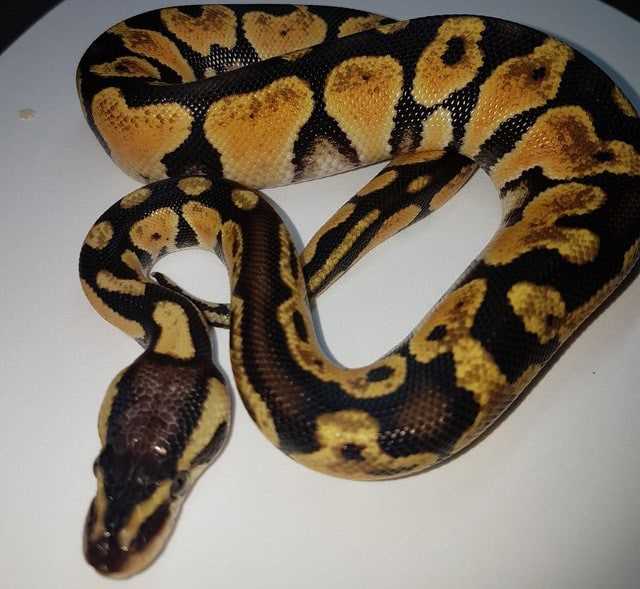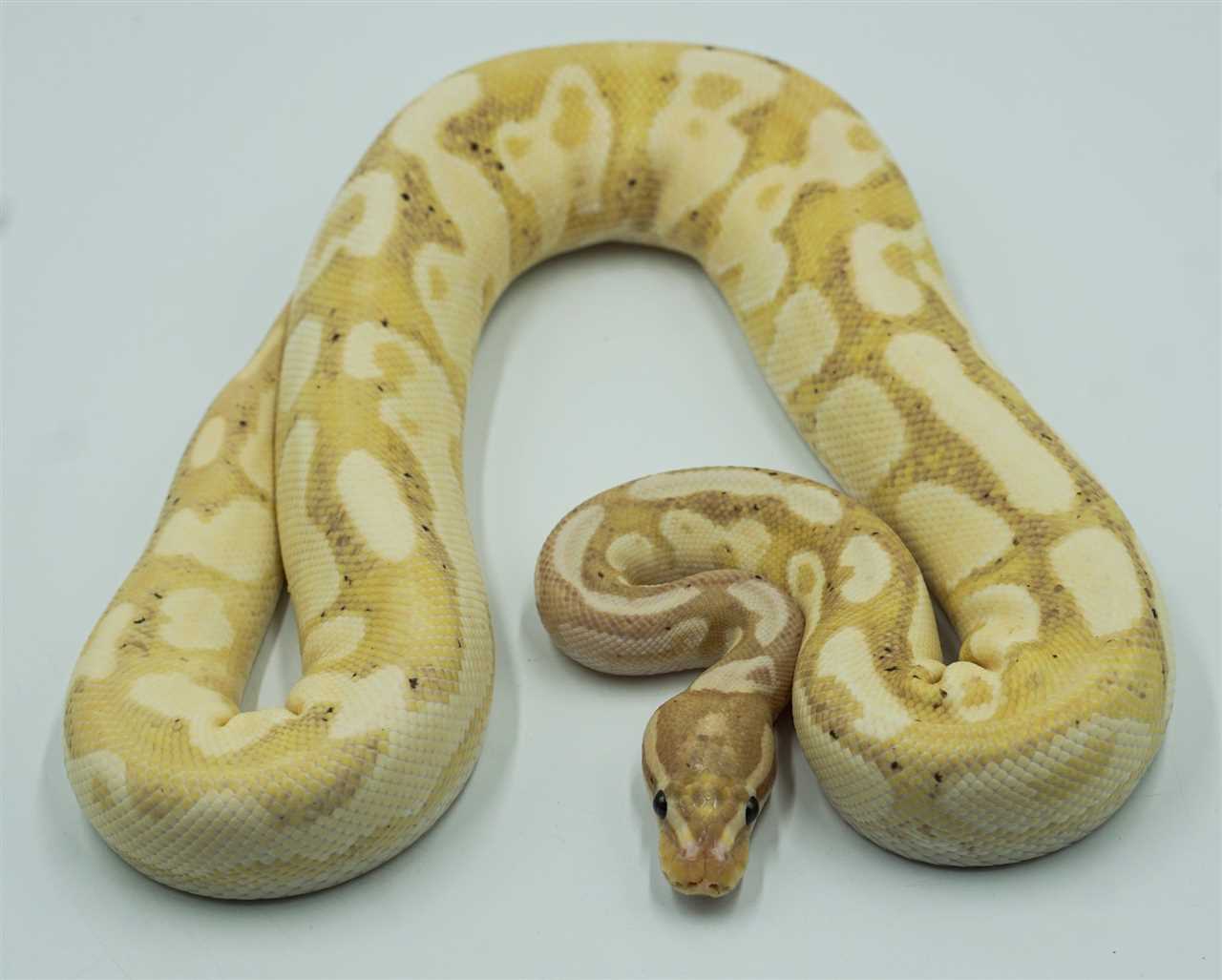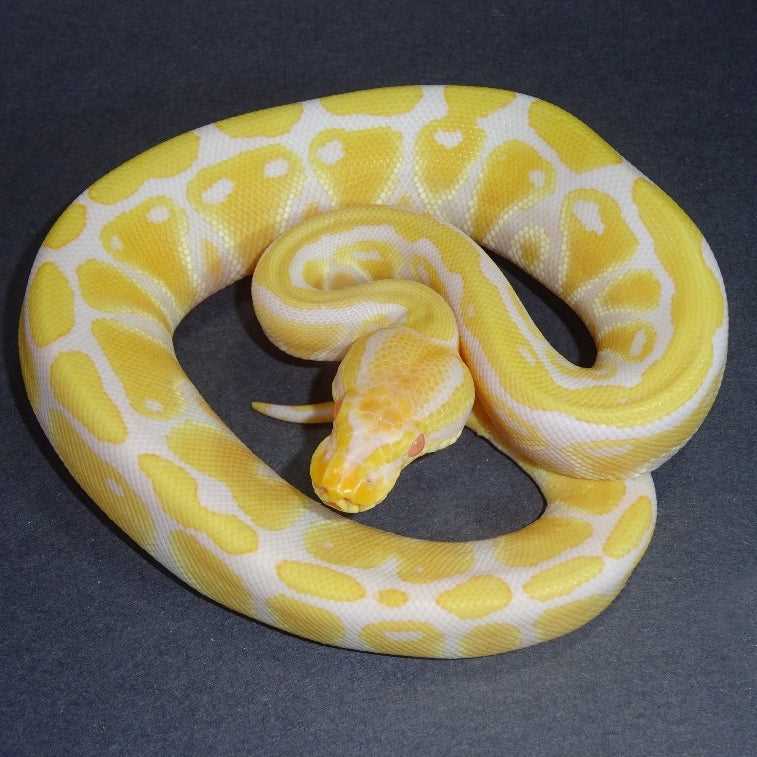
The yellow ball python is a colorful serpent that has become increasingly popular as a pet among reptile enthusiasts. With its striking yellow scales, this snake is a captivating addition to any collection.
The yellow ball python is particularly sought after for its unique coloration. While most ball pythons come in shades of brown or black, the yellow morph stands out with its vibrant and eye-catching scales. This color variation is caused by a genetic mutation that affects the production of pigments in the snake’s skin.
Yellow Ball Python: A Complete Guide
Morphs and Genetics of Yellow Ball Pythons
Housing and Enclosure for Yellow Ball Pythons
The enclosure should be equipped with a secure lid or top to prevent the snake from escaping. It should also have proper ventilation to maintain good airflow. The substrate, or bedding, should be a material that holds moisture, such as cypress mulch or coconut husk fiber.
Additionally, the enclosure should include hiding spots, such as reptile caves or hollow logs, where the yellow ball python can retreat and feel secure. It is essential to provide a temperature gradient within the enclosure, with a warm side and a cool side, to allow the snake to regulate its body temperature.
Feeding and Diet for Yellow Ball Pythons
Feeding should occur once every 1-2 weeks, depending on the age and size of the snake. It is essential to offer prey items that are appropriately sized to prevent regurgitation or other digestive issues. Feeding should take place in a separate container to avoid the ingestion of substrate or cage debris.
Temperature and Humidity Requirements for Yellow Ball Pythons
Yellow ball pythons require specific temperature and humidity levels to thrive. The enclosure should have a temperature gradient with a warm side ranging from 88-92°F (31-33°C) and a cool side around 78-82°F (25-28°C). This temperature difference allows the snake to thermoregulate by moving between the warm and cool areas.
The humidity levels in the enclosure should be maintained between 50-60%. This can be achieved by misting the enclosure regularly and providing a water bowl large enough for the snake to soak in if desired. Proper humidity is crucial for shedding, as it helps the snake’s skin to loosen and come off easily.
Handling and Care for Yellow Ball Pythons
When handling a yellow ball python, make sure to support its body and avoid squeezing or putting excessive pressure on it. Avoid sudden movements or loud noises that may startle the snake. It is recommended to handle the snake for short periods, starting with a few minutes and gradually increasing the duration over time.
Common Health Issues in Yellow Ball Pythons
Yellow ball pythons, like any other pet reptile, can be prone to certain health issues. Some common health problems include respiratory infections, scale rot, parasitic infestations, and mouth rot. It is essential to monitor the snake’s behavior, appetite, and shedding patterns regularly.
If you notice any signs of illness or abnormalities, it is advised to consult a reptile veterinarian who can provide proper diagnosis and treatment. Regular veterinary check-ups are also recommended to ensure the overall well-being of your yellow ball python.
Breeding and Reproduction of Yellow Ball Pythons
Breeding yellow ball pythons can be a rewarding experience for reptile enthusiasts. However, it requires careful planning and knowledge of the snake’s breeding behavior. Prior to breeding, it is essential to ensure that both the male and female yellow ball pythons are healthy and of appropriate age and size.
Successful breeding often involves introducing the male and female snakes together in the same enclosure with proper temperature and humidity conditions. This stimulates the breeding behavior, and if successful, the female will lay a clutch of eggs. The eggs should then be incubated at specific temperature and humidity levels until they hatch.
Overall, keeping and breeding yellow ball pythons can be a fascinating experience. With proper care, these captivating reptiles can thrive and bring joy to their owners for many years.
Morphs and Genetics of Yellow Ball Pythons
Yellow ball pythons are a popular morph of the ball python species, known for their vibrant yellow scales. These colorful reptiles are highly sought after as pets due to their unique appearance and relatively docile nature.
The distinctive yellow coloration of these pythons is the result of specific genetic traits. There are several different morphs of yellow ball pythons, each with their own genetic makeup and pattern variations. These morphs can range from light, lemon yellow to deep, golden hues.
Genetic Inheritance
In dominant inheritance, if a yellow python is bred with a normal python, all offspring will inherit the yellow gene and display the yellow coloration. However, if a normal python is bred with a yellow python, only some offspring will inherit the yellow gene and exhibit the yellow coloration.
In recessive inheritance, both parents must carry the yellow gene in order for offspring to inherit the yellow coloration. If only one parent carries the yellow gene, the offspring will not display the yellow coloration, but will carry the gene and can pass it on to future generations.
Pattern Variations
In addition to the coloration, yellow ball pythons can also exhibit various pattern variations. Some yellow pythons may have solid yellow scales throughout their body, while others may have contrasting patterns such as stripes or spots.
These pattern variations make each yellow ball python unique and highly prized by reptile enthusiasts and collectors.
Conclusion
Whether you are a first-time reptile owner or an experienced snake enthusiast, owning a yellow ball python can be a rewarding experience. Their beautiful yellow scales and calm demeanor make them a fascinating and attractive pet choice.
Housing and Enclosure for Yellow Ball Pythons
Size and Space
Ball pythons, including the yellow morph, can grow to be around 3 to 5 feet long. Therefore, it’s essential to choose a tank or terrarium that is large enough to accommodate their size. A general rule of thumb is to provide a enclosure that has a length at least equal to the length of the snake.
For a single adult yellow ball python, a tank with dimensions of 36 inch length, 18 inch width, and 12 inch height would be sufficient. However, providing a larger enclosure is always beneficial as it allows for more freedom of movement and allows the snake to exhibit more natural behaviors.
Substrate and Climbing
Providing climbing opportunities for the yellow ball python is also important. Adding branches, vines, or other decorative elements can allow the snake to explore and exercise its climbing abilities. Additionally, these enrichment items can offer hiding spots and vertical perches that mimic the snake’s natural habitat.
Temperature and Lighting
Yellow ball pythons, like other ball python morphs, require specific temperature and lighting conditions to maintain their health and well-being. A temperature gradient should be provided in the enclosure, with a warm side and a cool side.
The warm side of the enclosure should have a temperature range of 88-92°F, while the cool side should be around 75-80°F. This temperature gradient allows the snake to regulate its body temperature by moving between the different zones.
It’s also important to provide a source of UVB lighting in the enclosure. UVB lighting aids in the synthesis of vitamin D3, which is essential for calcium metabolism and overall bone health in snakes. A fluorescent UVB bulb placed above the enclosure can provide this necessary UVB radiation.
Hide Boxes and Water
Yellow ball pythons, like all ball pythons, appreciate having multiple hide boxes in their enclosure. These shelters provide a sense of security and allow the snake to retreat and feel safe. Place hide boxes on both the warm and cool side of the enclosure, ensuring that they are large enough for the snake to comfortably fit inside.
In addition to hide boxes, a large water dish should be provided in the enclosure. The dish should be large enough for the snake to soak in and should always contain fresh, clean water. Regularly check the water dish to ensure it is clean and replace the water as needed.
Overall, creating a suitable housing and enclosure for a pet yellow ball python is crucial for their health and well-being. Providing an appropriately sized enclosure, suitable substrate, temperature gradient, UVB lighting, hide boxes, and a water source will ensure that your pet snake thrives in their environment.
Feeding and Diet for Yellow Ball Pythons
Feeding and diet are important aspects of caring for a yellow ball python. As a reptile, this snake relies on a diet that consists mainly of small mammals, such as rodents. In captivity, it is common to feed them on pre-killed or frozen thawed rodents.
Feeding should take place in a separate enclosure to avoid any substrate or cage furnishings being ingested along with the prey. This can lead to digestive problems or impaction.
| Feeding Frequency | Prey Size | |
|---|---|---|
| Young Snakes | Every 5-7 days | Pinky Mice or Rat Pups |
| Adult Snakes | Every 7-10 days | Small Rats |
Remember to always provide fresh water in a shallow bowl for your yellow ball python to drink and soak in if desired. Cleanliness is also crucial in maintaining a healthy diet for your pet snake.
Temperature and Humidity Requirements for Yellow Ball Pythons
Temperature
Yellow ball pythons are ectothermic, which means they rely on external sources of heat to regulate their body temperature. In their natural habitat, these snakes prefer temperatures ranging from 78 to 90 degrees Fahrenheit (25 to 32 degrees Celsius). To create a suitable environment for your yellow ball python, you will need to provide a temperature gradient in their enclosure.
Humidity
Humidity is another important factor to consider when caring for yellow ball pythons. In their natural habitat, these snakes thrive in environments with humidity levels of around 50 to 60%. Maintaining proper humidity levels is crucial for shedding and overall hydration.
To ensure the right humidity levels for your yellow ball python, you can use a hygrometer to monitor the humidity levels in the enclosure. Mist the enclosure with water regularly to help maintain the humidity. In addition, you can provide a moist hide for your snake, which is a small enclosed area filled with damp substrate to provide a higher humidity microclimate for shedding.
Handling and Care for Yellow Ball Pythons
1. Handling

Before attempting to handle your yellow ball python, make sure it has been properly acclimated to its new environment. This will help reduce stress for the snake and minimize the chances of it becoming defensive or aggressive.
Keep in mind that yellow ball pythons are generally docile, but they can become stressed or agitated if handled too frequently or roughly. It is recommended to limit handling sessions to a few times a week for shorter durations to ensure the snake’s well-being.
2. Habitat and Enclosure
Creating a suitable habitat for your yellow ball python is essential for its overall health and well-being. Provide a spacious enclosure with proper heating and humidity levels.
3. Feeding and Diet
4. Temperature and Humidity
Yellow ball pythons require specific temperature and humidity levels to thrive. Provide a temperature gradient in the enclosure, with a warm side ranging from 88-92°F (31-33°C) and a cooler side around 75-80°F (24-27°C).
Maintain a humidity level of 50-60% for yellow ball pythons. This can be achieved by providing a water dish, regular misting, and using a humidifier if necessary.
Regularly monitor the temperature and humidity levels using reliable thermometers and hygrometers to ensure they are within the appropriate range.
By following these guidelines for handling and care, you can ensure the well-being and happiness of your yellow ball python. Remember to always research and consult with experts to provide the best possible care for your snake.
Common Health Issues in Yellow Ball Pythons

1. Respiratory Infections
One of the most common health issues seen in yellow ball pythons is respiratory infections. These infections, often caused by inadequate temperature and humidity levels, can lead to symptoms such as wheezing, open-mouth breathing, and nasal discharge. To prevent respiratory infections, it is crucial to provide the snake with a properly maintained habitat and ensure that the temperature and humidity levels are within the recommended range.
2. Respiratory Parasites
3. Scale Rot
Another health issue that yellow ball pythons may encounter is scale rot. Scale rot is a bacterial infection that occurs when the snake’s scales become damaged or wet for extended periods of time. This can happen if the snake’s enclosure is too damp or if the substrate is not properly maintained. To prevent and treat scale rot, it is necessary to provide a dry and clean environment for the snake to live in.
4. Mouth Rot
Breeding and Reproduction of Yellow Ball Pythons
Before introducing the male and female together, it is crucial to provide them with a suitable breeding environment. This typically includes a large enclosure with hiding spots and appropriate temperature and humidity levels. The enclosure should also be equipped with a nesting box where the female can lay her eggs.
The breeding process usually begins with a period of courtship between the male and female pythons. During this time, the male will attempt to impress the female by displaying various behaviors, such as vibrating his tail and rubbing against her body. If the female is receptive, she will often respond by raising her tail and allowing the male to curl around her.
After a gestation period of approximately 30 to 40 days, the female will lay her eggs. Yellow ball pythons are oviparous, meaning that they lay eggs rather than giving live birth. The female will typically lay a clutch of 6 to 12 eggs, which she will coil around to protect and incubate.
Once the eggs have hatched, the baby pythons will emerge from their shells. At this stage, they are fully independent and capable of hunting and feeding on their own. It is essential to provide them with the appropriate size and type of prey to ensure healthy growth and development.

I’m Lena Adams—a product of an unconventional upbringing in the African wilderness. My father, a daring explorer of African wildlife, sparked my fascination with reptiles, a passion that intertwined with the tragic loss of my mother during an expedition, leaving an indelible mark on my life. Driven to understand the creatures that captivated my parents, I embarked on my journey, sharing insights about reptiles, frogs, and lizards on my website. Through my explorations and conservation efforts, I honour my family’s legacy while seeking connections—to the creatures, nature, and the mother whose presence I yearn to understand.
